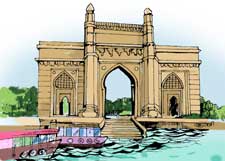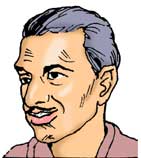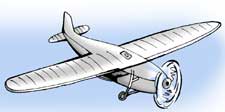
Dimdima
Online Children's Magazine from India

Dimdima
Online Children's Magazine from India

When the Portuguese came to India five centuries ago, the seven islands that constitute the city were small fishing villages of little consequence. One of these islands, Bombay (Mumbai), was gifted to Charles II when he married the Portuguese princess, Catherine Braganza in 1661. Later the Portuguese ceded the other six islands to the British. Over the years the seven islands were connected by causeways and Bombay soon emerged as the commercial capital of India.
Mumbai has a coastline that is 64 km long. On the northwest lies the fishing village of Versova, where the fisherfolk Kolis, the original inhabitants of Mumbai live in large numbers. The Koli staple fish, the silvery bombil or Bombay Duck, is a great favourite with the fish-eating Mumbaikars.
 A couple of kilometres from Versova lies Juhu, which has the most popular beach in Mumbai.
A couple of kilometres from Versova lies Juhu, which has the most popular beach in Mumbai.
In 1932, J.R.D. Tata made aviation history when he landed his aircraft, the Puss Moth here at Juhu. This marked the beginning of the  country's national carrier, Air India.
country's national carrier, Air India.
Further south along the coast, one can see the Basilica of Mount Mary, atop a hill in Bandra. It was built by the Portuguese in 1640.
On an islet in the bay at Worli, stands the Haji Ali Dargah, built eight centuries ago. It contains the tomb of Pir Haji Ali Azrat Bukhhari.
Like Juhu beach, Chowpatty beach at the foot of the Malabar Hill, is associated with aviation. Exactly a hundred years ago, a Vedic scholar, Shivkar Bapuji Talpade is said to have flown his plane over the beach. This was eight years before the Wright brothers made thair historical flight.
The Chowpatty beach, like all the beaches of Mumbai, gets busiest during the Ganesh Chaturthi festival, when small and gargantuan-sized idols of Lord Ganesh are immersed in the sea.
Mumbai witnessed a great deal of the country's struggle for freedom. The Indian National Congress was born here and it was here that the 'Quit India' resolution was passed by Congress on 8 August, 1942.
Mumbai Stock Exchange is the oldest in the country. It was founded in 1877 at Dalal street. The present Stock Exchange building was built a hundred years later.
Mumbai today is the busiest and the biggest port in the country. The Sassoon, Prince's, Alexandria, Indira or Victoria docks were built between the 1870's and 1970's. Bombay's satellite port, the Jawaharlal Nehru Port, lies at Nhava-Sheva, two little islands, 11 km across the harbour.
The city is also the film capital of the country and is called Bollywood — India's Hollywood.
Mumbai's most famous landmark is the Gateway of India, a massive stone arch of yellow basalt, that stands facing the Arabian Sea. It was built in 1911 to welcome King George and Queen Mary of England. Appropriately, the last of the British soldiers were flagged off through the Gateway of India when the country became independent.
Last updated on :10/29/2004
Dimdima is the Sanskrit word for ‘drumbeat’. In olden days, victory in battle was heralded by the beat of drums or any important news to be conveyed to the people used to be accompanied with drumbeats.
Bharatiya Vidya Bhavan
K. M Munshi Marg,
Chowpatty, Mumbai - 400 007
email : editor@dimdima.com
Bharatiya Vidya Bhavan
505, Sane Guruji Marg,
Tardeo, Mumbai - 400 034
email : promo@dimdima.com
Dimdima.com, the Children's Website of Bharatiya Vidya Bhavan launched in 2000 and came out with a Printed version of Dimdima Magazine in 2004. At present the Printed Version have more than 35,000 subscribers from India and Abroad.